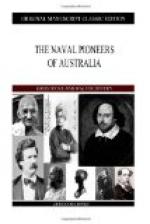In due course the ship sailed in continuation of her voyage. Then on the night of Monday, April 28th, 1789, the master, John Fryer, had the first watch, the gunner, William Peckover, the middle watch, and Fletcher Christian, the senior master’s mate, the morning watch. Just as the day was breaking, when the ship was a few miles to the southward of Tofoa, one of the Friendly Island group, Bligh was rudely awakened by the entrance to his cabin of Christian and three of the crew. He was told he would be killed if he made the least noise, and Christian, armed with a cutlass, the others with muskets and fixed bayonets, escorted him to the deck, after first tying his hands behind him. The master, the gunner, the acting surgeon, Ledward (the surgeon had died and was buried at Tahiti), the second master’s mate, and Nelson, one of the botanists, [Sidenote: 1789] were at the same time secured below. The boatswain, carpenter, and clerk were allowed to come on deck, and the boatswain, acting under threats from the mutineers, hoisted out the launch.
Bligh used every endeavour, first by threats, and then by entreaties and promises of forgiveness, to induce the crew to return to their duty, and Fryer, the master, if he had received the least support, would also have made an attempt to retake the ship. But the mutineers threatened instant death to any who attempted resistance.
The boat being hoisted out, the names of certain of the officers and crew were called, and these were ordered to enter her. Bligh was compelled to follow, and she was then dropped astern. Christian handed Bligh a sextant and a book of nautical tables, saying, as he did so, “This book is sufficient for every purpose, and you know, sir, my sextant is a good one.” Four cutlasses, a 28-gallon cask of water, 150 pounds of bread, 6 quarts of rum, 6 bottles of wine, 32 pounds of pork, twine, canvas, sails, some small empty water-casks, and most of the ship’s papers were put in the boat, and she was cast adrift.
At the last moment, according to Bligh, Christian, in reply to a question as to what sort of treatment was this in return for all the commander’s kindness, said, “That, Captain Bligh, that is the thing: I am in hell”; according to the evidence at the court-martial, not of mutineers, but of the master and other officers who were cast adrift from the Bounty, what Christian did say was in reply to entreaties to reconsider what he was doing, when his words were—“No, no. Captain Bligh has brought all this on himself: it is too late; I have been in hell for weeks past.”
With Bligh in the boat were eighteen persons, and twenty-five remained on the Bounty. The boat was 23 feet in length, 6 feet 9 inches in breadth, and 2 feet 9 inches in depth. When loaded with all these people and her stores, she had not seven inches of freeboard.
From the morning when the boat was cast adrift till forty-two days later, when her unhappy company were safely landed at Timor, Bligh’s behaviour and the behaviour of those under him is a noble example of courage, endurance, and resourcefulness.




